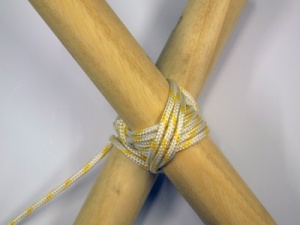
Introduction
A Diagonal Lashing is used to bind two poles together that cross each other but do not touch (or are likely to be pulled apart) when their ends are lashed in place in a structure. Often used for securing diagnal braces used to hold a structure rigid.
When wooden poles are used in a lattice like structure a combination of Diagonal and Square lashings is used to hold them together.
The Diagonal Lashing can be used to bind poles that cross at an angle of between 90 to 45 degrees. If the angle between the poles is less than 45 degrees a sheer lashing should be used.
Note: If a square lashing was used to bind poles that do not touch the beginning clove hitch would pull the cross pole towards it causing unnecessary bowing of the cross pole and could also produce a force that would act along the length of the pole to which the clove hitch is tied. This could place unnecessary strain on other lashings and cause the structure to twist and fail.
Step by Step Guide
- Tie a Timber Hitch horizontally around two poles crossed diagonally. Pull tight. Take the working end around to the back of poles ready for the first turn.
- Start the wrapping turns on the opposite diagonal to the timber hitch. Pull the rope tight so that the poles contact each other. Make three full horizontal turns around both poles and over the Timber Hitch. Pull each turn tight as it is made.
- Change the direction of the turns by taking the rope behind the poles a the bottom of the lashing then to the front of the poles at the top. Try to go around the pole when changing direction to avoid crossing the first set of wrappings diagonally.
- Make three vertical wrapping turns around the crossed poles tightening each turn before making the next one. Be sure to keep them parallel.
- Tighten the lashing with a frapping turn by going past and around one of the poles and then threading the rope alternately behind then in front of each pole. This will help to secure the lashing.
- Make two more frapping turns, pulling each one tight as it is completed.
- End the lashing with a clove hitch by taking the first half hitch of the clove hitch by going past and then around one of the poles. Lock the half hitch tight against the lashing by working it tight and pulling it from below.
- Take a second half hitch around the pole and work it tight against the first so that the clove hitch is locked tight against the lashing.
